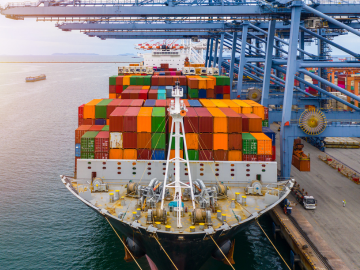Navigating waves of change: Insights from the frontiers of sustainable shipping

How do you foresee the adoption of alternative fuels in the maritime sector, and how can Hapag-Lloyd support this evolution?
At the beginning of July, the International Maritime Organisation (IMO) adopted its revised Greenhouse Gas (GHG) Emissions strategy. The strategy includes an enhanced common ambition to reach net-zero GHG emissions from international shipping close to 2050. On a separate note, the European Union (EU) also introduced the "Fit for 55" programme in 2021 which aims to reduce GHG emissions by 55% by 2030. As an EU-based shipping company, both policies are relevant to us.We fully support this increased ambition and the wider sustainability efforts within the maritime sector, and we have set ambitious targets of our own to contribute to our industry’s transition while we are aiming to become net-zero by 2045.
For our existing fleet, we have launched a Fleet Upgrade Programme (FUP) and started by retrofitting vessels with new and more efficient propellers and by optimising the vessel designs. These improvements will lead to a consumption reduction of regular bunker fuel, and thus also CO2 emissions, by around 7%. With regards to the use of alternative fuels, we are evaluating retrofitting existing vessels to green methanol propulsion, which would reduce our CO2 footprint substantially once this fuel is available at scale. Unfortunately, availability is the main issue for all alternative fuel types at the moment.
To achieve a timely CO2 reduction, we therefore chose to order liquefied natural gas (LNG) powered vessels in 2020. The first two of these newbuilds, the Berlin Express and the Manila Express, have just been added to our fleet. While fossil LNG saves between 15 to 25 % CO2and significantly reduces other air pollutants, it is our intention to substitute LNG with either bio-methane or synthetic methane in the medium-term once these fuels are widely available.
Hapag-Lloyd AG (HLAG) sustainability-linked bonds (SLBs) are displayed on LGX. Why did you choose this format?
We became aware that other companies operating in our industry had issued SLBs in northern Europe and concluded that this would also be the right fit for us. It’s also worth noting that the notes of our SLB are structured in accordance with ICMA’s Sustainability Linked Bond Principles.Now, Luxembourg is a leading financial centre in both Europe and throughout the world, with a strong track record. It offers a unique, business-oriented financial ecosystem and a stable legal framework. We also have a longstanding history with the Luxembourg Stock Exchange (LuxSE), having issued six bonds here, the first of which was back in 2010. In 2021, our SLB also became the first of our bonds to be displayed on the Luxembourg Green Exchange (LGX).
Overall, our experience working with LuxSE over the past 13 years has been a very positive one from all points of view. LGX is completely aligned with our own sustainability targets and ambitions and taking into account the platform’s leading position in the field of sustainable finance, it was a choice that made sense for us
What benchmarks did you decide to use to calibrate your Sustainability Performance Targets (SPTs)?
As one of the world’s leading liner shipping companies, our aim is to integrate an effective climate protection strategy across our fleet operations by increasing energy efficiency, introducing strict requirements for newbuilds, and taking measures to reduce bunker consumption. Setting our SPTs was a one-time opportunity to reimagine the financing of our company and prepare ourselves for the new era of the shipping industry. Based on this, Hapag-Lloyd committed to an SPT Trajectory to reduce the carbon intensity of our owned fleet by 60% until 2030 compared to the year 2008 baseline.
To measure the carbon intensity, we decided to use the Average Efficiency Ratio (AER) as a KPI – it is robust, measurable and verified, and we felt it ticked all the right boxes for us. AER is the industry standard for measuring carbon intensity, and the metric is recognised to be consistent with the policies and regulations of IMO-DCS, a mandatory regulation established by the IMO for the data collection and reporting of fuel oil consumption from ships.
How did investors welcome your inaugural SLB? Did the SLB format allow you to broaden your investor base?
There is obviously a growing demand for sustainable investment opportunities. Our SLB was very well received by the market and witnessed a strong over-subscription, which also helped reinforce our wider Sustainability Strategy. It’s also worth pointing out that Hapag-Lloyd became the first container shipping company worldwide to offer an SLB, which was also very well received by our stakeholders.As for the investor base, this SLB enabled us to reach new types of investors, many of which were not familiar with our industry. In parallel, our efforts also resonated with our existing investor base. In total, we received very positive feedback from investors – which is also reflected in the bond pricing.
Did the target KPI set within that SLB help reinforce the company focus on sustainability?
Absolutely. This financial instrument has helped to drive our sustainability targets and has led to an increased focus on sustainability across the company. The experience gained through the process also helped us develop our enhanced Sustainability Strategy which was established at the end of 2021.As a result, our Sustainability Strategy is an integral part of our overall Strategy in that our environmental objectives are aligned with our business goals moving forward. This is reflected in the management compensation package which is now also tied to our SPT.
Can you share your views and expectations on the development of sustainable finance in the maritime sector?
Five years ago, sustainable finance was just a buzzword, but today it’s the new norm. With the increasing regulatory pressure and a growing call for sustainable shipping initiatives from customers and wider society, sustainable finance in the maritime sector will gain even more importance in the years to come.In this respect, Hapag-Lloyd has been a forerunner in the development of sustainable finance opportunities within the container shipping Industry. In 2020 and 2021 we issued Green Loans and one Green Lease according to the Green Loan Principles. In 2021, we issued the first high yield SLB in container shipping – and have since issued additional sustainability-linked loan financing facilities which are based on the same concept as the bond. We certainly intend to issue more instruments using the aforementioned concepts in the future.

